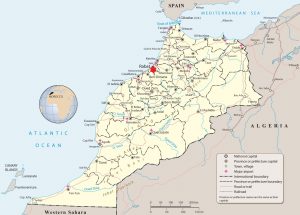Rabat
- Rabat
Rabat is the capital of Morocco. Rabat was founded in the 12th century by the Almohad ruler. (Almohad Caliphate is a Berber Muslim group.) The city grew steadily but went into an extended period of decline following the collapse of the Almohads. In the 17th century Rabat became a haven for Barbary pirates. The French established a protectorate over Morocco in 1912 and made Rabat its administrative center. Morocco achieved independence in 1955 and Rabat became its capital.
We loved the theme of our hotel in Rabat. A library was painted on the wall behind the registration desk and another wall displayed many books. Outside was a bicycle carrying books!
- registration desk
- wall display
- at entrance
We only had one day in Rabat. We saw some interesting places near our hotel and then toured several historical spots. We visited Dâr-al-Makhzen, the primary and official residence of the king of Morocco. It was built in 1864.
- note accessible ramp created by steps
- a Berber
- Catholic church
- tram
- optical illusion – can you find the actual side of building?
- Contemporary art museum
- one of the gates
- Royal Palace
- entrance to palace
- palace guards
- minaret on palace grounds
- our guide
Near the Palace is the Chellah which is a medieval fortified Muslim necropolis. The Phoenicians established a trading emporium at the site. It later became a site of an ancient Roman colony. It was rebuilt in the 13th century. A complex of mosque, minaret, and royal tombs was built. There is an eel pool where barren women used to come to bathe and expect to be able to conceive.
- entrance to Chellah
- outer wall
- at the entrance
- dinosaur?
- walkway to ruins
- eel pool
- cats!
- woman feeding bread to eels
- ancient minaret
- tombs
- tomb of ruler who built on the site
- Koranic inscriptions
- “pulpit” area of mosque
- ruins
- old Roman settlement
- millstone from Hercules caves
- ancient minaret (with stork nest)
- Roman stele from 2nd century
- old Roman road
The Mausoleum of Mohammed V is located on the opposite side of the Hassan Tower. It contains the tombs of the Moroccan king (Mohammed V) and his two sons, King Hassan II and Prince Abdallah. A reader of the Koran is often present, having his assigned seat. (Not there when we visited.) Its construction was completed in 1971.
Hassan Tower is the minaret of an incomplete mosque in Rabat. Commissioned in 1195, the tower was intended to be the largest minaret in the world along with the mosque, also intended to be the world’s largest. When the caliph died in 1199, construction on the mosque stopped. The tower reached 44 m (140 ft), about half of its intended 86 m (260 ft) height. The rest of the mosque was also left incomplete, with only the beginnings of several walls and 348 columns being constructed.
- entrance to Mausoleum grounds
- Mausoleum
- guard
- Moroccan tourists
- detail
- grave of Mohammed V – note the open Koran
- ceiling
- guard inside
- wall
- more mosaic
- Hassan Tower with unfinished pillars
Our companion at lunch!
- no music!
We visited the Kasbah on the coast. It is at the junction of the Atlantic Ocean and the Bouregreg River. Besides providing protection, it held a large slave trade – both black and white slaves. On a street leading into the Kasbah, our guide stopped to talk with a young man repairing shoes. He was from Senegal and had been here several months. Senegalese do not need visas to come to Morocco.
- coast
- along coast
- Kasbah grounds
- current king with prince and forefathers
- Senegalese shoe repairer
- slave market
- Bouregreg River
- river
- outside Kasbah
- descending stairs out of Kasbah
- Berber living in Israel
In the evening we had our Welcoming Dinner (this is the start of the main trip). It was held in a beautiful Riad (former home) Restaurant. We had a fabulous meal.
- our guide to restaurant
- inside restaurant
- us!
- fellow travelers from CA
- music entertainment
- appetizers
- stuffed vegetables
- dessert
- restaurant



































































